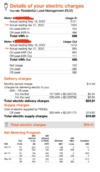So PSEG now has a specific EV program for charging.
New Jersey is on track to become one of America's leading states for transportation electrification, and PSE&G is helping to make it happen. Through our Electric Vehicle Charging Program, we're supporting the large-scale deployment of residential, mixed-use (commercial), and public Direct...

nj.myaccount.pseg.com
It's great that they pay $1500 for the charger installation including charger, but the night time discount is only $0.02 per KwH. It needs a wifi enabled charger to work. Only the power that get used by the charger gets the discount.
Whole house time of use rates (RLM) give you a discount of about $0.14 per KwH but they increase the service charge about $10. So you only need to charge about 83KwH per month to have it be a better deal. (0.14-0.02)/10=83.3.
I think for most people it will make more sense to try to get the whole house (RLM) set up. We use about 500-600Kwh charging the cars per month and I think this will be pretty typical. This saves you about $60 per month, just on charging. Remember the whole house is getting the discount on weekends and night so the real savings can be higher. The EV Program using a wifi enabled charger will only save you about $10 a month (500*$0.02) =$10 but has the upfront reward of paying for the charger installation.
I know PSEG can be difficult to get the time of use rates/meter. I would still try to go this direction as the savings are so much better, especially if you already have a charger installed. I honestly think PSEG put this EV program in place to avoid too many people trying to go on full home time of use. People will get set up on the EV program and think, great I got my charger paid for and I am getting a discount.
What I am not sure of is if you can get both programs. I doubt they will do it, but I read though eligibility and it does not seem to exclude the time of use program. The point is you may get the $1500 for the charger but they may not further discount your rate at night if you are already on time of use or try to switch to time of use. There is a federal tax credit on charger of 30% that could also be used to offset the charger installation cost
Anyway, I will try to monitor this thread. Just wanted to make people aware of this program and the pro/cons.



